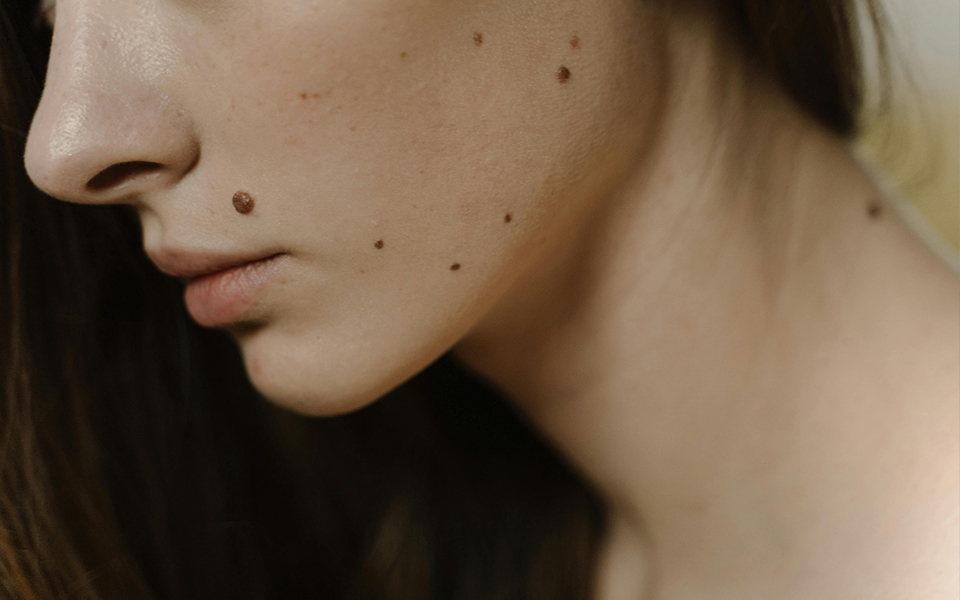Early detection plays a critical role in the successful treatment of skin cancer. Among the most effective techniques for early detection of melanoma and other skin cancers is mole mapping, a process that employs advanced imaging techniques to keep a meticulous track of moles and other skin lesions.
What is Mole Mapping and How Does it Work?
Mole mapping is an advanced dermatological procedure aimed at creating a comprehensive mole map of the patient’s skin. This entails recording the size, shape, and location of each mole through detailed images, allowing for systematic monitoring over time.
The primary objective is to detect any changes in existing moles or identify new lesions at an early stage, thereby facilitating timely skin cancer detection and treatment.
The cornerstone of the mole mapping procedure is total body photography. This involves taking high-resolution images of the patient’s entire skin surface. These images serve as a baseline that dermatologists can refer to during subsequent skin cancer checks.
Additional techniques, such as dermoscopy, may be employed for enhanced visualisation of suspicious lesions. The collected data is stored in a secure digital database, forming a body mole map that assists in the meticulous monitoring of the patient’s skin health over time.
How Often Should You Schedule a Mole Mapping Appointment?
The frequency of mole mapping appointments varies based on individual risk factors, such as a family history of skin cancer, fair skin, or a high number of moles.
As a general guideline, those at high risk of skin cancer may need to undergo a full-body photography session annually.
Regular mole checks are integral to ensuring any abnormal changes are promptly identified, making the early detection of skin malignancies possible.
Why is Early Detection of Skin Cancer Important?
Skin cancer poses significant health risks if not identified and treated early. Melanoma, in particular, is notorious for its rapid progression and potential to metastasise to other parts of the body.
The earlier skin cancer is detected, the more likely it is that the treatment will be successful. Consequently, a timely skin check can mean the difference between life and death.
Mole maps play a vital role in the early detection of melanoma. By maintaining a detailed, visual record of the moles on a patient’s skin, dermatologists can easily identify alterations in existing moles and the appearance of new lesions.
This systematic comparison of images over time facilitates the early identification of potential melanomas, enabling prompt intervention and improving prognosis.
How to Prepare for a Mole Mapping Appointment?

Your initial visit to a skin cancer clinic for mole mapping can be a straightforward process. The appointment typically begins with a consultation, where the dermatologist or GP reviews your medical history and assesses your risk factors.
Following this, a thorough skin examination is conducted, including total body photography to capture images of your skin from multiple angles. This is a non-invasive procedure and generally painless, designed to provide a comprehensive baseline for future comparisons.
Steps for Getting Ready for a Total Body Photography Session
Preparation for a total body photography session primarily involves ensuring your skin is free from any temporary marks or cosmetics. Here are some steps to help you get ready:
- Perform a Self-Exam: Before your appointment, conduct a self-exam and note any new, changing, or unusual spots on your body to discuss with the dermatologist. This helps in identifying signs of skin cancer early.
- Avoid Self-Tanners/Spray Tans: Discontinue the use of any self-tanner or spray tans for one to two weeks before your exam, as these can alter the colour and pattern of your moles.
- Remove Nail Polish: Ensure your nails are free of polish so the dermatologist can examine the nails on your fingers and toes for any signs of skin cancer.
- Wear Your Hair Down: Let your hair down to allow the dermatologist to take a close look at your scalp.
- Avoid Makeup: Do not wear makeup to the visit, or use the face wash provided at the clinic to remove makeup before your exam. This ensures a clear view of the skin on your face.
- Moisturise: Apply moisturiser to help normalise the appearance of your moles if your skin is dry.
Keep in Mind the ABCDEs: When examining your moles, look for:
- Asymmetry: One half of the mole doesn’t match the other half.
- Borders: Edges that are irregular, scalloped, or poorly defined.
- Colours: Multiple colours or an uneven distribution of colour.
- Diameter: Greater than ¼ inch (about 6mm).
- Evolution: Any change in size, shape, colour, or symptoms such as itching or bleeding.
Questions to Ask Your Dermatologist or GP
- What is the frequency of follow-up appointments?
- What are the specific procedures involved in skin cancer detection?
- What measures are taken for tracking changes in moles over time?
- What are the steps involved in body photography?
- How will the images be used for diagnosis and treatment?
Understanding these aspects will help set realistic expectations and alleviate any concerns you may have.
What Happens During a Skin Cancer Check with Mole Mapping?
A skin cancer check with mole mapping typically involves several key stages. Initially, the dermatologist will perform a visual examination of your skin, focusing on any moles or lesions that appear suspicious.
Next, total body photography is conducted, followed by more detailed imaging of specific areas if necessary. Any new or altered lesions identified during this process will be closely monitored and potentially biopsied to confirm the diagnosis.
Body photography and lesion imaging are fundamental components of mole mapping. High-resolution images are crucial for documenting the state of the skin at each check, providing an essential reference point for future comparisons.
Dermoscopic imaging, which magnifies the surface of skin lesions, can be particularly valuable for distinguishing between benign moles and potentially malignant lesions. These advanced imaging techniques ensure a thorough skin examination and enhance the accuracy of skin cancer detection.
Who Should Consider Mole Mapping?

With over 18,257 cases of melanoma diagnosed in Australia in 2023, the need for early detection cannot be overstated. Considering that more than 95% of skin cancers are linked to UV radiation exposure, individuals at high risk should particularly consider mole mapping as part of their routine skin health management.
- High-Risk Groups – Individuals with fair skin, a history of sunburns, or a family history of skin cancer are at high risk. They need mole mapping the most. It helps them catch changes early. Fair-skinned people have less melanin, which protects against UV radiation. If they’ve had sunburns, their skin damage increases. Those with skin cancer in their families carry higher genetic risks. For these groups, regular screenings can be life-saving.
- Large number of moles – People with numerous moles should consider mole mapping. Especially if they have over 50 moles, having many moles raises the chance of developing melanoma. Mole mapping creates a detailed record. Doctors use it to spot new moles or changes quickly.
- Atypical Moles – Those with atypical moles, also known as dysplastic nevi, need mole mapping. These moles look different and may turn into melanoma. Atypical moles might be larger and have uneven borders or colours. Tracking these through mole mapping aids in the early detection of problematic changes.
- Seeking Assurance – Mole mapping isn’t just for those at high risk or with many/atypical moles. It’s also for anyone wanting a thorough skin check. Even if you don’t think you’re at risk, mole mapping provides peace of mind. It ensures any changes in your skin are noted and addressed quickly.
- Large or Unusual Moles: Moles that are large or have unusual colours or shapes also need to be closely monitored.
- Sun Exposure: Individuals with a lot of sun exposure, including outdoor workers and people who take regular sun holidays, are at higher risk. Sun damage accumulates over time and increases the likelihood of skin cancer.
- Immune System: Those with a suppressed immune system are more vulnerable to skin cancers and should undergo regular mole mapping.
- Previous Melanoma: Individuals with a previous history of melanoma are at a higher risk of recurrence and should undergo regular mole mapping sessions.
- Recent Changes to Moles: If you have noticed any recent changes to moles on your skin — such as changes in size, shape, or colour—it’s essential to undergo a mole mapping session.
Mole mapping serves as an invaluable tool in the arsenal against skin cancer. It complements traditional skin checks by providing a detailed record of moles and their evolution.
Patients benefit from this advanced method as it aids in the early detection of melanoma and other skin cancers. By keeping a vigilant eye on changes in their skin, individuals can ensure they receive timely care, potentially saving lives.
How Can Mole Mapping Provide Peace of Mind?
Monitoring and Tracking Changes Over Time
Mole mapping provides peace of mind by allowing continuous monitoring and tracking of changes in your skin over time. By maintaining a detailed record of your moles, dermatologists can quickly identify any new lesions or changes in existing moles that may indicate the early stages of skin cancer. This proactive approach ensures that any suspicious signs are addressed promptly, reducing anxiety and enhancing the effectiveness of skin cancer screening.
Benefits of Non-Invasive Skin Cancer Screening
One of the significant advantages of mole mapping is its non-invasive nature. Unlike other forms of cancer screening that may require biopsies or other invasive procedures, mole mapping relies on advanced imaging techniques that are painless and non-disruptive.
This makes it an accessible and stress-free option for regular skin checks, making it easier for patients to adhere to recommended screening schedules.
Why Regular Mole Checks are Crucial for Skin Health
Regular mole checks are essential for maintaining optimal skin health. They enable the early identification of abnormal changes, facilitating prompt intervention and increasing the chances of successful treatment.
By routinely undergoing mole mapping, individuals can proactively manage their skin health, reducing the risk of severe outcomes and contributing to overall peace of mind. Molemap skin cancer clinics provide specialized services in this regard, ensuring comprehensive care and ongoing support.
Summary
Mole mapping serves as a critical tool in the early detection of skin cancer, offering a comprehensive approach to monitoring changes over time. It benefits individuals at high risk and those with numerous moles by providing a detailed record, aiding in the swift identification of potential problems.
The choice between a standard skin check and mole mapping depends on one’s specific health profile and risk factors. Experts in dermatology recommend mole mapping for its thoroughness and ability to track the evolution of skin lesions.
FAQ
Mole mapping is particularly effective for detecting melanoma and other types of skin cancer that develop from moles. However, it may not identify non-melanoma skin cancers like basal cell carcinoma or squamous cell carcinoma that do not originate from moles. Regular skin checks by a dermatologist are essential for comprehensive skin cancer screening.
Insurance coverage for mole mapping varies depending on your provider and policy. Some insurance plans may cover the procedure if it’s deemed medically necessary due to high-risk factors. It’s advisable to check with your insurance provider beforehand to understand your coverage options.
If a suspicious mole is identified during mole mapping, your dermatologist will likely perform a more detailed examination, possibly using dermoscopy. If further investigation is needed, a biopsy may be recommended to determine if the mole is cancerous. Early detection and intervention are crucial for effective treatment.
Yes, children can undergo mole mapping, especially if they have a high number of moles or a family history of skin cancer. Early and regular monitoring can help detect any changes in moles as they grow, ensuring any potential issues are addressed promptly.

